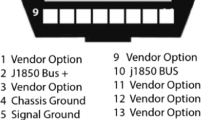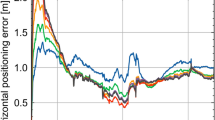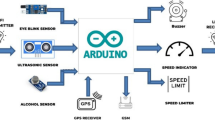Abstract
The use of noise maps in large cities has become a common practice since they have been recognized as a powerful tool for determining the population exposure to environmental noise and, therefore, a valid aid to identify the most appropriate mitigation actions. The possibility to complement noise maps with further information such as the vehicle speed distribution, can represent an additional benefit to local Municipalities. The well-known fact that speed is the most relevant characteristic to discriminate between different vehicle noise spectra, led us to perform a dedicated measuring campaign devoted to record both vehicle features (noise spectrum and speed). The recorded spectra have been statistically analyzed and classified according to their speeds. Three main spectral patterns, corresponding to different mean speed, have been derived. Such patterns have been used, first, for discriminating among non-vehicle noises and, second, they have been associated with vehicles travelling within a certain speed interval. The results suggest that this method can prove useful in practical situations in which traffic noise and vehicle mobility need to be controlled/assessed.










Similar content being viewed by others
References
Journal article
Altman NS (1992) An introduction to kernel and nearest-neighbor nonparametric regression. Am Stat 46(3):175–185
Averbuch A, Rabin N, Schclar A, Zheludev V (2012) Dimensionality reduction for detection of moving vehicles. Pattern Anal Appl 15(1):19–27
Ballesteros JA, Sarradj E, Fernández MD, Geyer T, Ballesteros MJ (2015) Noise source identification with Beamforming in the pass-by of a car. Appl Acoust 93:106–119
Brock G, Pihur V, Datta S, Datta S (2008) clValid: an R package for cluster validation. J Stat Softw 25(4):1–22
Can A, Gauvreau B (2015) Describing and classifying urban sound environments with a relevant set of physical indicators. J Acoust Soc Am 137:208–218
Donoho DL (2006) Compressed sensing. IEEE Trans Inf Theory 52(4):1289–1306
Fraley C, Raftery AE (2002) Model-based clustering, discriminant analysis and density estimation. J Am Stat Assoc 97(458):611–631
Glegg S, Yoon J (1990) Determination of noise source height, Part I: the measurement of equivalent acoustic source height above a reflecting surface. J Sound Vib 143(1):19–37
Hartigan JA, Wong MA (1979) A K-means clustering algorithm. Appl Stat 28(1):100–108
Romberg J, Candes E, Tao T (2006) Robust uncertainty principles: exact signal reconstruction from highly incomplete frequency information. IEEE Trans Inf Theory 52(2):489–509
Kakar VK, Kandpal M (2013) Techniques of acoustic feature extraction for detection and classification of ground vehicles. Int J Emerg Technol Adv Eng 3(2):419–426
Savage R (1961) Probability inequalities of the Tchebycheff type. J Res Natl Bur Stand B Math Math Phys 65B:3
Sharan RV, Moir TJ (2016) An overview of applications and advancements in automatic sound recognition. Neurocomputing 200:22–34. doi:10.1016/j.neucom.2016.03.020
Smiraglia M, Benocci R, Zambon G, Roman HE (2016) Predicting hourly traffic noise from traffic flow rate model: underlying concepts for the DYNAMAP project. Noise Mapp 3(1):130–139
Torija JA, Ruiz DP (2016) Automated classification of urban locations for environmental noise impact assessment on the basis of road-traffic content. Expert Syst Appl 53:1–13
Ward JH (1963) Hierarchical grouping to optimize an objective function. J Am Stat Assoc 58(301):236–244
Wu H, Siegel M, Khosla P (1999) Vehicle sound signature recognition by frequency vector principal component analysis. IEEE Trans Instrum Meas 48(5):1005–1009
Zambon G, Benocci R, Bisceglie A, Roman HE, Bellucci P (2016a) The LIFE DYNAMAP project: towards a procedure for dynamic noise mapping in urban areas. Appl Acoust. doi:10.1016/j.apacoust.2016.10.022
Zambon G, Benocci R, Brambilla G (2016b) Cluster categorization of urban roads to optimize their noise monitoring. Environ Monit Assess 188(1):26 (1–11)
Zambon G, Benocci R, Brambilla G (2016c) Statistical road classification applied to stratified spatial sampling of road traffic noise in urban areas. Int J Environ Res 10(3):411–420
Zambon G, Roman HE, Benocci R (2017) Scaling model for a speed-dependent vehicle noise spectrum. J Traffic Transp Eng (English Edition) 4(3):230–239. doi:10.1016/j.jtte.2017.05.001
Zuo F, Li Y, Johnson S, Johnson J, Varughese S, Copes R, Liu F, Wu HJ, Hou R, Chen H (2014) Temporal and spatial variability of traffic-related noise in the City of Toronto, Canada. Sci Total Environ 472:1100–1107
Book, authored
Kaufman K, Rousseeuw P (1990) Finding groups in data. Wiley, Hoboken
Sandberg U, Ejsmont JA (2002) Tyre/road noise reference book. INFORMEX Ejsmont & Sandberg Handelsbolag Harg, Sweden
Paper presented at a conference
Alías F, Socoró JC, Sevillano X, Nencini L (2015) Training an anomalous noise event detection algorithm for dynamic road traffic noise mapping: environmental noise recording campaign. In: Proceedings of the 46th national congress on acoustics, Valencia, Spain, 21–23 October
Benocci R, Roman HR, Zambon G, Radaelli S (2014) Traffic acoustical classes based upon vehicle characteristics. In: Proceedings of forum acusticum, Krakow, Poland, 7–12 September
Socoró JC, Albiol X, Sevillano X, Alías F (2016) Analysis and automatic detection of anomalous noise events in real recordings of road traffic noise for the LIFE DYNAMAP project. In: Proceedings of the 45th international congress and exposition on noise control engineering, Hamburg, Germany, 21–24 August
Socoró JC, Ribera G, Sevillano X, Alías F (2015) Development of an anomalous noise event detection algorithm for dynamic road traffic noise mapping. In: Proceedings of the 22nd international congress on sound and vibration, Florence, Italy, 12–16 July
Wang W, Qi H (2002) Acoustic target classification using distributed sensor arrays. In: Proceedings of IEEE ICASSP, Orlando, FL, USA, 13–17 May
Zambon G, Benocci R, Brambilla G, Gallo V (2014) Statistics-based functional classification of roads in the urban area of Milan. In: Proceedings of forum acusticum, Krakow, Poland, 7–12 September
Zambon G, Angelini F, Benocci R, Bisceglie A, Radaelli S, Coppi P, Bellucci P, Giovannetti A, Grecco R (2015) DYNAMAP: a new approach to real-time noise mapping. In: Proceedings of EuroNoise 2015, Maastricht, Holland, 31 May–3 June
Internet publication/Online document
Bruitparif (2015). http://carto.bruitparif.fr
Deliverable 11 of IMAGINE project (2007) The noise emission model for European road traffic. https://www.mp.nl/sites/all/files/publicaties/IMA55TR-060821-MP10%20-%20IMAGINE%20Deliverable%20D11.pdf
Ometron (2013) Areas of vibrometer applications. http://www.ometron.com/applications/index.html
Package ‘signal’(2015) https://cran.r-project.org/web/packages/signal/signal.pdf. Accessed 30 Jul 2015
R Development Core Team (2011) R: a language and environment for statistical computing. the R Foundation for Statistical Computing, Wien, Austria. ISBN: 3-900051-07-0. http://www.R-project.org/. Accessed 30 Jul 2015
Regulation n° 51–Addendum 50-Rev. 1 (2007) Uniform provisions concerning the approval of motor vehicles having at least four wheels with regard to their noise emission. Regulation UN/ECE, Geneva, Switzerland. https://www.unece.org/fileadmin/DAM/trans/main/wp29/wp29regs/R051r2e.pdf. Accessed 29 Nov 2011
Ruhala R (1999) A study of tire/pavement interaction noise using nearfield acoustical holography. Ph.D. thesis, The Pennsylvania State University, USA. https://www.researchgate.net/publication/234493207_A_study_of_tirepavement_interaction_noise_using_near-_field_acoustical_holography. Accessed 21 Oct 2015
SENSEable (2011) PISA, Italy, 2011. http://senseable.it/
SADMA El Sistema de Actualización Dinámica del Mapa Acústico de Madrid, Madrid, Spain, 2006. http://digital.csic.es/handle/10261/8325. Accessed Oct 2006
Technical Reports
Fraley C, Raftery AE, Murphy TB, Scrucca L (2012) mclust version 4 for R: Normal Mixture Modelling for Model-Based Clustering, Classification, and Density Estimation. Tech. Rep. No. 597, Department of Statistics, University of Washington, USA
General Motors North American Engineering Standards (2004) Road tire noise evaluation procedure. Test procedure GMN7079TP, General Motors Corporation, Detroit, MI, USA
Hald J (1995) Use of spatial transformation of sound fields (STSF) techniques in the automotive industry. Bruel & Kjaer, Technical Review, 1, Nrerum, Denmark
ISO 362–1 (2007) Measurement of noise emitted by accelerating road vehicles—engineering method—Part 1: M and N categories. ISO, Geneva
Tsaig Y, Donoho DL, Drori I, Strack JL (2006) Sparse solution of underdetermined linear equations by stage wise orthogonal machine pursuit, Technical report N. 2006-2, Department of Statistics, Stanford University, USA
Author information
Authors and Affiliations
Corresponding author
Rights and permissions
About this article
Cite this article
Zambon, G., Roman, H.E. & Benocci, R. Vehicle Speed Recognition from Noise Spectral Patterns. Int J Environ Res 11, 449–459 (2017). https://doi.org/10.1007/s41742-017-0040-4
Received:
Revised:
Accepted:
Published:
Issue Date:
DOI: https://doi.org/10.1007/s41742-017-0040-4




